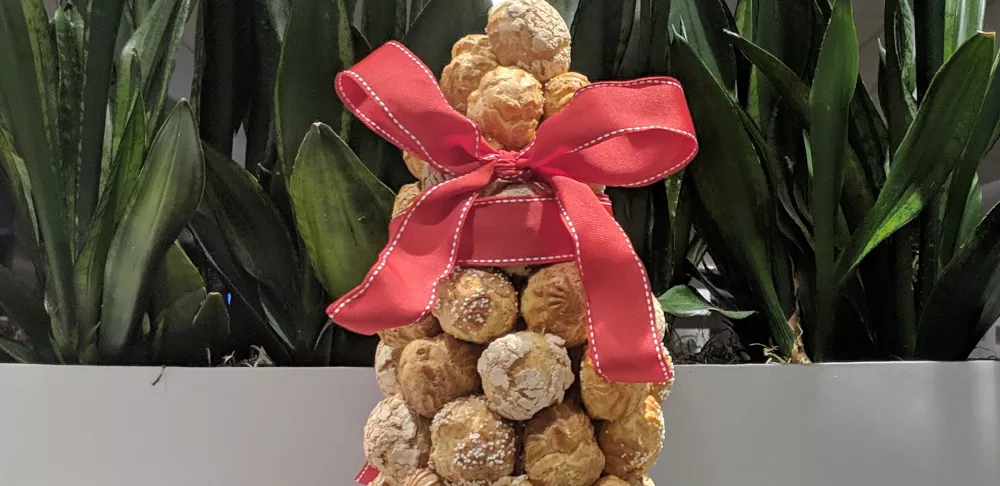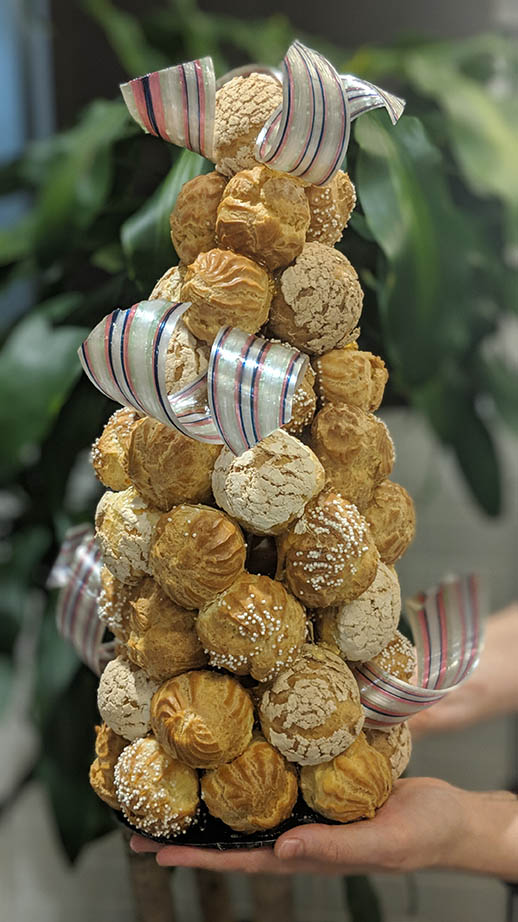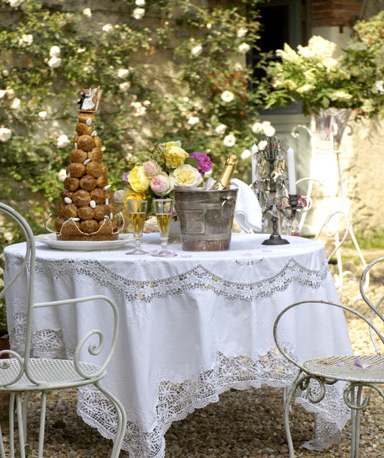 The French pastry tower is a festive treat for celebratory occasions.
The French pastry tower is a festive treat for celebratory occasions.
If you get married in France, your wedding cake is traditionally a croquembouche (a cone-shaped compilation of choux pastry balls). American-style wedding cakes are coming to France, but the French still firmly believe in having a croquembouche for the celebration.
At the annual ICE Cuisine Course in France, which I have been running for 20 years, we've built croquembouches at a pastry shop, La Duchesse Anne, in Saumur. All ICE culinary and pastry students are taught the techniques required to assemble a croquembouche.
What is a croquembouche?
The literal translation of croquembouche is “to crackle in the mouth” because it is a tapered tower of petits choux (small cream puffs) filled with pastry cream that are “glued” together with caramelized sugar. Here, granulated sugar is cooked above hard-crack stage (320°F on a candy thermometer), often to a light caramel, and becomes solid at room temperature. So if you eat a choux (cream puff) as part of a croquembouche, it crackles in your mouth as you crunch on the hard shell into the crisp cream puff and soft pastry cream filling.
The first time I saw a croquembouche was when I was in pastry school in Washington, D.C. One of my classmates had to make one for our final buffet — decorated in traditional style with nougatine and royal icing.
Once at ICE several years ago, Chef Cathy Kaufman and I ran a Marie-Antoine Carême savory and dessert class in which one of the pièces montées (confectionery centerpieces) was a croquembouche with nougatine in the shape of a lute. The class ate dinner with traditional dishes originally created by Carême as he worked his way around Europe with his entourage of chefs, and then we demolished the desserts far more quickly than the time it took to create them all!
Study pulling sugar with Chef Kathryn in Pastry & Baking Arts.
How do you make and decorate a croquembouche?
At ICE, Pastry & Baking Arts students finish their first module learning to make, pipe and bake pâte a choux (the dough used to make cream puffs). They also make pastry cream for the first time in the program and practice cooking caramel to glue a croquembouche together.
Pulled sugar ribbons and bows are often used in France to decorate wedding cakes. For some reason in America, this has become “approximated” with spun sugar or angel hair (which is too thin to be structural). I think it must be because some spun sugar or angel hair is inadvertently formed as you glue the croquembouche together — but for the croquembouche to “last,” spun sugar or angel hair should be carefully removed from the assembled tower.

However, spun sugar or angel hair is its own technique, and if done correctly, it can be beautiful. Overcooked, the sugar will taste bitter and burnt. If you want a snowy-white spun sugar for a wintertime effect, cook it only to 320°F. If you want golden spun sugar, cook the sugar to a medium caramel, something above 330°F but below 340°F. The caramel “glue” should not be too dark, and any spun sugar or angel hair decoration should not be dripping off of the croquembouche. The problem with this type of décor is it will not last long if it is humid — the sugar is so thin that it melts.
Another way to modernize a croquembouche is to use fondant for the outside of the choux (like on éclairs or religieuses, as described in my book “Les Petits Sweets”), but you will still have to glue it together with cooked sugar/caramel for it to be structurally sound. In these photos, we adapted a version of Chef Michael Laiskonis’ pâte sablée (shortbread dough) from the ICE curriculum and used sprinkles.
Using a Silpat (silicone baking mat) helps you to create some dimensional depth in a croquembouche. For example, the backside is a textured grid. If you dip the choux in the caramel and place it flat, you will get a flat-top on your choux versus a shiny effect. Both are good — you have to make some style decisions in planning your own tower.
Find your culinary voice through the craft of cake decorating
Timing

In France, the croquembouche is a symbol for celebration, served on New Year’s Eve, for example. You can prepare the choux ahead of time and bake the day of the party because they leaven with steam and works even better if baked from a frozen state (a trick from my time working with Herve Poussot at Le Bernardin). The pastry cream filling will hold for about four days in your refrigerator. Choux can be dipped in caramel early in the day — just don’t dip your fingertips in the molten sugar.
Once you fill the choux with the pastry cream, they can start to get soft. Yet if you glue your tower together with caramel, it is generally not best stored in the refrigerator where the humidity can soften sugar and make your tower collapse. So making a croquembouche is more of a timing challenge rather than a technical challenge as it needs to be assembled the same day as you’re going to serve it.
I would not wrap your croquembouche in plastic wrap — it can sweat and soften. Just try to time it close to when you need it for guests. I have pre-dipped choux in caramelized sugar to be ready to fill with the cream last minute and stored them successfully in an air-tight container with a desiccant (drying substance).
To make the hollow wall of choux, some choose to buy a croquembouche mold, which is a metal hollow cone (think a traffic cone, but metal). You oil it up and get a completely different size croquembouche if you assemble the tower on the outside of the greased cone and slide the metal out, or you assemble the tower on the inside of the greased cone and twist the croquembouche out.
The best tip I've learned for cooked sugar to hold the longest is from Jacques Torres, who I worked with at Le Cirque. We used to make spun sugar clown hair for one of the signature desserts with 50/50 glazing fondant and glucose and cook it to hard crack stage. This will hold in an air-tight container with a desiccant and isomalt, which can be used but can turn into a laxative in large quantities. (Ergo, only glue a croquembouche together with isomalt when it is strictly for display.) Once I helped make five-foot-tall croquembouches at the Waldorf-Astoria hotel, which were on display by the sweeping staircase from Thanksgiving to New Year’s.
Lastly, people sometimes wonder how to serve this crackling tower they’ve built and securely fastened together. It can actually be hard to break apart. Servers at The Rainbow Room once used two silver spoons to gently whack a serving of three choux to place on a plate. It works.
Here’s how to make (a hollow) one for yourself, and serve it to friends for your New Year’s celebration. Bonne année!
Croquembouche
Pâte Sablée
Adapted from Chef Michael Laiskonis
- 60 grams soft unsalted butter
- 60 grams confectioners’ sugar
- 60 grams all purpose flour
- 1 gram fine sea salt
- powdered food color
Pâte à Choux
Adapted from "Les Petits Sweets," by Gordon/McBride, Running Press, 2016
- 4 large eggs
- 185 grams milk
- 85 grams unsalted butter
- 2 grams fine sea salt
- 115 grams all purpose flour
Matcha Pastry Cream
Adapted from "Les Petits Sweets," by Gordon/McBride, Running Press, 2016
- 3 large eggs
- 30 grams cornstarch
- 1 gram fine sea salt
- 300 grams milk
- 6 grams matcha tea powder
- 75 grams granulated sugar
- 30 grams unsalted butter
- 2 grams vanilla extract
Hard-Crack Sugar or Caramel
Attributed to Jacques Torres
- 200 grams glazing fondant
- 200 grams glucose
Step 1: Pâte Sablée
- Cream butter and confectioners’ sugar on mixer with paddle until fluffy. Add flour, salt and powdered color, and mix until a dough forms.
- Roll out dough thinly on lightly floured sheet of parchment. Refrigerate for a half hour, then cut into 1-inch disks to place on top of choux before baking. Keep chilled until ready to use.
Step 2: Pâte à Choux
- Whisk eggs in a bowl. Heat milk, butter and salt in a medium sauce pan until boiling. Add in the flour all at once, stirring with a wooden spoon until a ball forms, pulls away from the sides of the pan, and a skin begins to form at the bottom of the pan.
- Remove from heat and place on mixer with paddle. Stir ¾ of the eggs into the flour/milk mixture. Add additional egg until the mixture becomes clask, or begins to move if you draw the spoon through the dough.
- Place in a pastry bag and cut a hole that’s ½-inch across. Pipe 1-inch mounds on a parchment-lined sheet pan. Top with rounds of pâte sablée. Bake in pre-heated 400°F oven for 10 minutes; lower heat to 375°F and bake 20 more minutes, until light and golden brown with a very crisp shell.
Note: Choux can be made ahead, piped and frozen. Place (frozen) in pre-heated oven and add 5 minutes to baking time.
Step 3: Matcha Pastry Cream
- Whisk eggs in a medium bowl, and whisk in cornstarch and salt.
- Whisk milk, matcha powder and sugar in a medium-large saucepan over medium heat, and bring to a boil. Whisk eggs into hot milk, stirring vigorously. Bring to a boil over medium heat, whisking constantly. The bubbles will subside, the mixture will thicken and begin to boil. Remove from heat after mixture boils 1 minute. Place in mixer bowl with butter and vanilla, stir cool with paddle.
Note: can be made ahead and refrigerated for up to four days when cool.
Step 4: Hard-Crack Sugar or Caramel
- Place in a sauté pan. Bring to a boil, stirring gently. Use a calibrated candy thermometer to cook to 320°F for a shiny effect or to 330°F for a golden effect. Immediately stop the cooking by plunging the bottom of the pot into a bowl of ice water for 15 seconds.
- Carefully dip the tops of the baked choux in the caramel. Use the caramel to “glue” together the croquembouche. Reheat over low heat as necessary to maintain fluidity.
Tips:
- Cook more sugar for assembling your croquembouche than you think you need so the mass can help retain heat and let you keep decorating and creating your tower.
- Be careful if you are cooking the caramel to glue together the croquembouche and re-heat the sugar as it will keep darkening. You do not want that to happen – it is better to recook sugar from scratch than overheat caramel and burn it. The croquembouche will also be darker as you glue the choux together, almost like a reverse ombre.
- Remember, the easiest way to clean a pot of cooked sugar or caramel is to fill it with water and boil it out.
Study with Chef Kathryn in ICE's Pastry & Baking Arts program.
Pastry & Baking Arts Holidays Travel Global Cuisine Recipe Pastry & Baking Arts Pate Sablee;Step 1 - Cream butter and confectioners sugar on mixer with paddle until fluffy. Add flour, salt and powdered color, and mix until a dough forms; Step 2 - Roll out dough thinly on lightly floured sheet of parchment. Refrigerate for a half hour, then cut into 1-inch disks to place on top of choux before baking. Keep chilled until ready to use; Pate a Choux;
Step 1 - Whisk eggs in a bowl. Heat milk, butter and salt in a medium sauce pan until boiling. Add in the flour all at once, stirring with a wooden spoon until a ball forms, pulls away from the sides of the pan, and a skin begins to form at the bottom of the pan; Step 2 - Remove from heat and place on mixer with paddle. Stir ¾ of the eggs into the flour/milk mixture. Add additional egg until the mixture becomes clask, or begins to move if you draw the spoon through the dough; Step 3 - Place in a pastry bag and cut a hole that’s ½-inch across. Pipe 1-inch mounds on a parchment-lined sheet pan. Top with rounds of pâte sablée. Bake in pre-heated 400°F oven for 10 minutes, lower heat to 375°F and bake 20 more minutes, until light and golden brown with a very crisp shell; Matcha Pastry Cream;
Step 1 - Whisk eggs in a medium bowl, and whisk in cornstarch and salt; Step 2 - Whisk milk, matcha powder and sugar in a medium-large saucepan over medium heat, and bring to a boil. Whisk eggs into hot milk, stirring vigorously. Bring to a boil over medium heat, whisking constantly. The bubbles will subside, the mixture will thicken and begin to boil. Remove from heat after mixture boils 1 minute. Place in mixer bowl with butter and vanilla, stir cool with paddle; Hard-Crack Sugar or Caramel;
Step 1 - Place in a sauté pan. Bring to a boil, stirring gently. Use a calibrated candy thermometer to cook to 320°F for a shiny effect or to 330°F for a golden effect. Immediately stop the cooking by plunging the bottom of the pot into a bowl of ice water for 15 seconds; Step 2 - Carefully dip the tops of the baked choux in the caramel. Use the caramel to “glue” together the croquembouche. Reheat over low heat as necessary to maintain fluidity; Swirl
 Orange
Off
Orange
Off


Ty chef Micheal
Submitted by Ronnie kulick on December 31, 2018 1:21pm
I cannot believe it's been almost 19 years since graduating ICE. After all of this time I really should have went to pastry arts. Jaques Torres was my inspiration to go, but I wanted to learn fundimentals and history of all. Worked with many in NYC. Learned much. I'm boArderline diabetic but I still have a passion for chemisty, art and love of sweets! Don't know if you would ever remember me. But I respected and listed to your guidance in thank you.
Add new comment